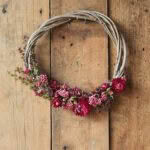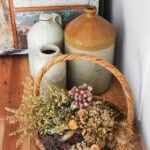Lynda Hallinan’s Blog: The liberation of dried-flowers
Before the tanks run dry in summer, this land-lover raids her cottage-style picking garden for buds, blooms and seedheads to hang in her dried-flower hut.
Photos: Sally Tagg
I was 18 when I planted my first flower garden. It was the summer of 1992, and cottage gardens were all the rage. By the end of that summer, my knickers smelled of lemon verbena and dried damask rose petals — thanks to the homemade potpourri sachets tucked into my bedside drawers.
And when I flicked through the pages of Southland florist Olive Dunn’s best-selling book, Delights of Cottage Gardening In New Zealand, pressed lobelia petals invariably fell out.
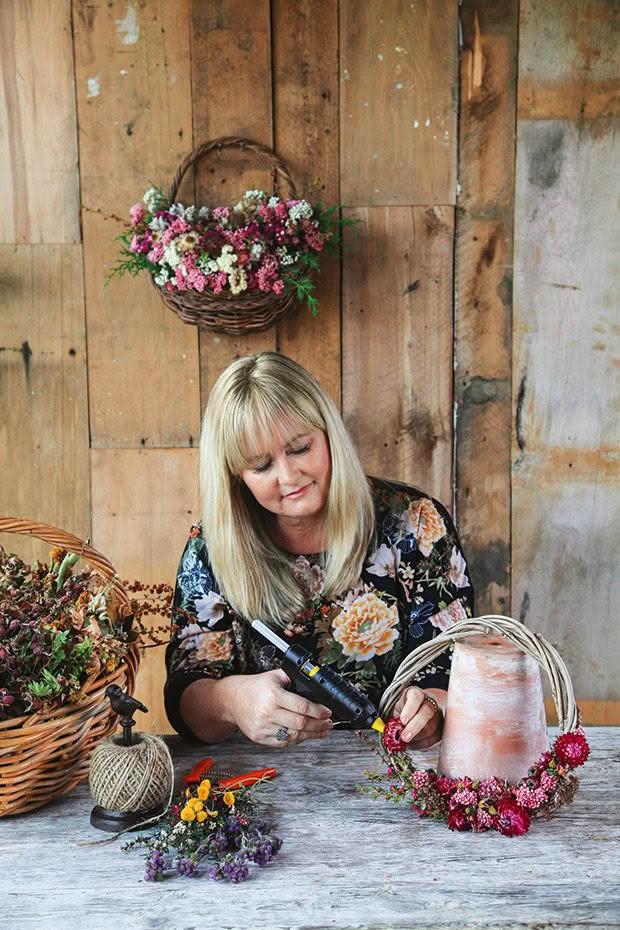
Tip: Use a hot glue gun to attach individual flowers or short sprigs and sprays to a wreath. Don’t worry about any ugly blobs of glue on the back side; no one will ever see them.
In the cottage garden heyday, standard iceberg roses with lilac bobby socks of catmint or english lavender marched two-by-two up villa paths, and waterfalls of purple wisteria strangled verandahs and swallowed sheds. I collected campanulas rather than antique ceramic crocks and grew scruffy cinnamon, chocolate and peppermint-scented pelargoniums instead of parsley, sage, rosemary and thyme.
Before Netflix, I binge-watched Maggie, Jack, Ruud, Bill and The Prof on Friday nights and bottled nasturtium pods — aka poor man’s capers — and tiny jars of rose-petal jam in my student flat.
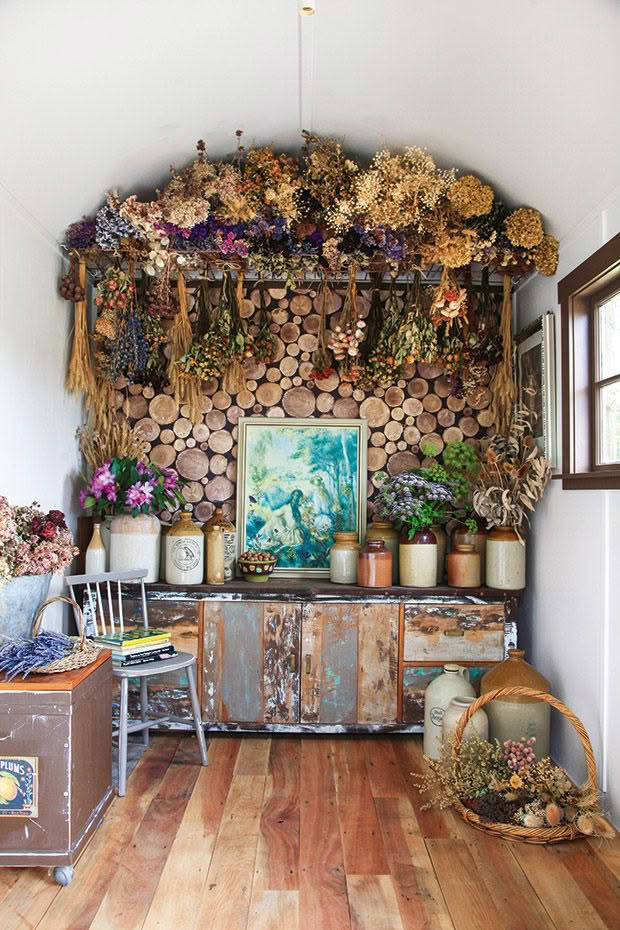
Lynda’s shepherd’s hut, which last featured in NZ Life & Leisure in 2016 as a sage-green “bric-a-brac shack”, has recently undergone a rustic renovation to house her dried flowers and a growing collection of antique crocks. The log wallpaper is Lumberjack in the beech colourway from the Andrew Martin Engineer Collection.
Call it nostalgia or innate laziness, but I suspect I will always have a soft spot for this casual style of gardening. Cottage gardens are populated with short-lived annuals, many of which are actually reckless weeds.
These floriferous fornicators spread their seeds wherever they please, returning year after year, although not necessarily where they are needed or wanted.
Cottage gardens are notoriously joyful in spring and utterly shabby by summer’s end, yet no one minds because, like me, Mother Nature doesn’t care a toss for tidiness.
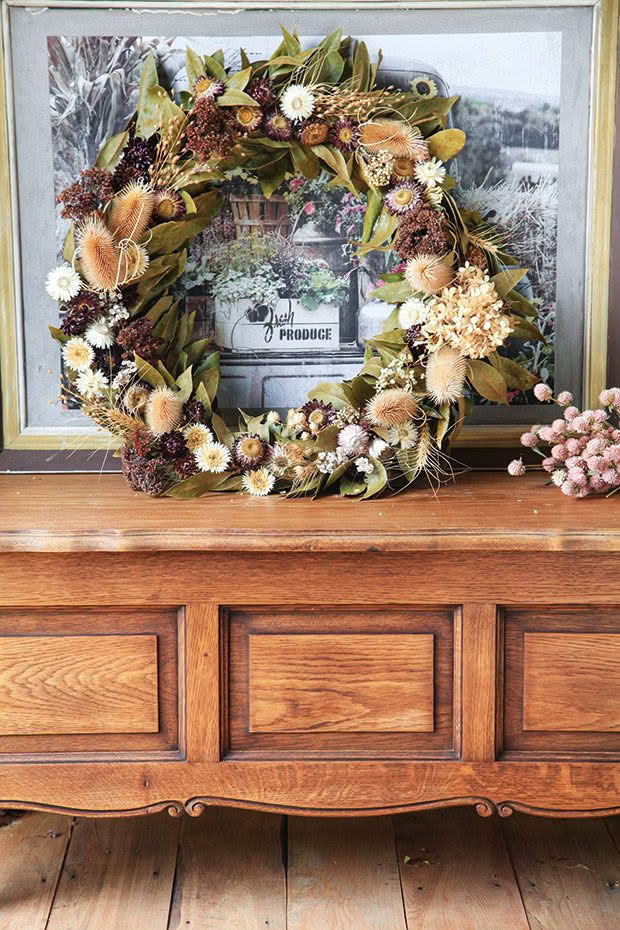
During the lockdown, Lynda made a kitchen wreath of fresh bay leaves (Laurus nobilis) to repel pesky pantry moths from her precious sourdough-flour supply. Once fully dry, she decorated it with thistle-like teasels, helichrysums, sedums, hydrangeas and golden ears of wheat.
My garden is vast but I merrily turn my back on the whole shebang and bugger off to the beach over the summer holidays, knowing full well that fretting over my (lack of) horticultural housekeeping standards won’t make a blind bit of difference to the desiccated, dishevelled mess I’ll return home to after another drought.
Should the skies fail to replenish our water tanks — not to mention Auckland’s reservoirs in the Hunua Ranges looming above our farm — at least there’ll be more to pick and hang inside my sweltering shepherd’s hut.
The hut has a curved hot tin roof that doubles as a rustic dehydrator and my dried-flower display room has bunches of everything from barley and wheat to larkspurs and queen anne’s lace either stacked above, or hung below, a sheet of steel reinforcing mesh tacked to the ceiling. It smells like a haybarn, albeit one with hints of rose, lavender, musk and myrrh to balance the grassy fragrance.
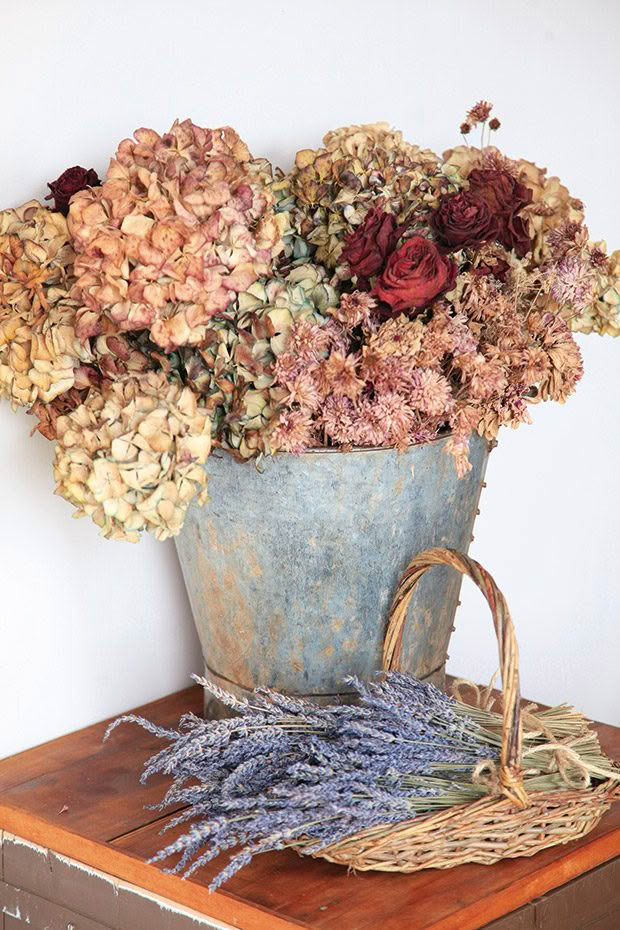
Dried hydrangeas, roses, chrysanthemums and english lavender.
Has it really been 20 years since everlastings (the name given specifically to the helichrysum daisy family and more generally to any flower that holds itself together once cut and dried) were so popular that the dried-flower selection in the Kings Seeds catalogue rivaled the gourmet vegetables?
And what a selection it was. All those rinky-dink delights such as baby’s breath, bachelor buttons, cottontails, cockscombs, honesty, love-in-the-mist, love-lies-bleeding, quaking oats, sea lavender, strawflowers and yarrow.
Dried flowers are back in a big way. They’re enjoying a modern revival — and a reinvention. And I for one couldn’t be more chuffed by the return of the immortelles, those old-time cottage charmers that die with dignity, giving their papery petals and sun-bleached seedpods a second crack at life in dried arrangements.
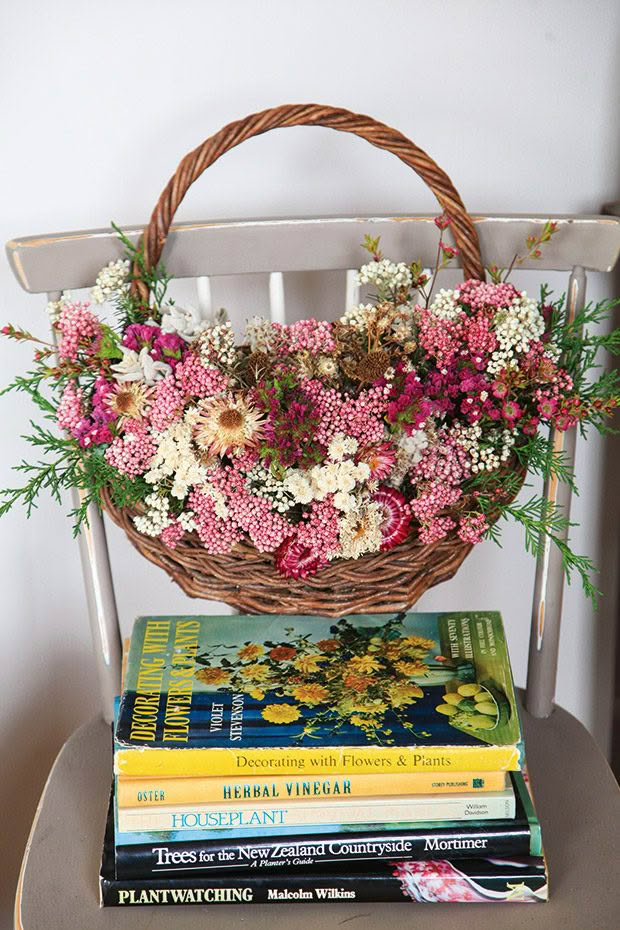
Liven up a dried wall-basket arrangement by tucking in a few sprigs of fresh cypress foliage and short-stemmed statice.
Unlike floral art, which is still policed by conservative rule-sticklers who consider it an unforgivable infraction to lack proportion, balance, harmony or rhythm, when working with dried flowers there is no book to go by. It’s a free for all.
Gone are the prissy little baskets of bolt-upright blue statice and orange strawflowers, their heads wired obediently into position. These days anything goes, from fluffy plumes of noxious pampas (hairsprayed into submission to stop its seeds shedding) to age-spotted hydrangeas and agricultural pests, including wild carrot.
On my wedding day a decade ago, I lugged a baby-bump-sized bunch of dahlias up the aisle. It was a stinking hot summer’s day, and by the time the DJ packed up at midnight, my bouquet was good for nothing but the compost bin.
- Lynda combined dried rose hips, sedum ‘Autumn Joy’ and burgundy helichrysum daisies with fresh sprigs of hybrid ‘Tickled Pink’ mānuka and bobbles of candy-pink ozothamnus ‘Royal Flush’ for this small wisteria wreath.
That all feels unsustainably sinful, especially as eco-conscious brides now gleefully commission dried-florist bouquets for destination weddings up in the boonies where fresh bouquets don’t travel well. (I wouldn’t recommend biffing one of these at an unwed bridesmaid, though. Someone could lose an eye to a spiky sea holly stem or thorny teasel.)
When I first started drying flowers, I’d use sachets of silica gel, bottles of glycerine, boxes of borax and bags of bentonite clay (aka kitty litter) to snuff the life out of my chosen blooms. Oh, how times have changed.
The last bag of kitty litter I bought wasn’t for embalming fading flowers, or even for cleaning up after an incontinent elderly cat, but to grind in a Nutribullet to plug the end of an icing sugar and potassium nitrate skyrocket for my son Lucas. Fireworks hold considerably more sway than dried flowers for a nine-year-old boy.
CUT AND DRIED
Harvest flowers for drying before the buds have fully opened, as overblown blooms won’t hold their colour and are likely to drop their petals.
Strip stems clean of greenery, leaving only a few upper leaves. Soft foliage holds a good deal more moisture than flowers and tends to turn mouldy.
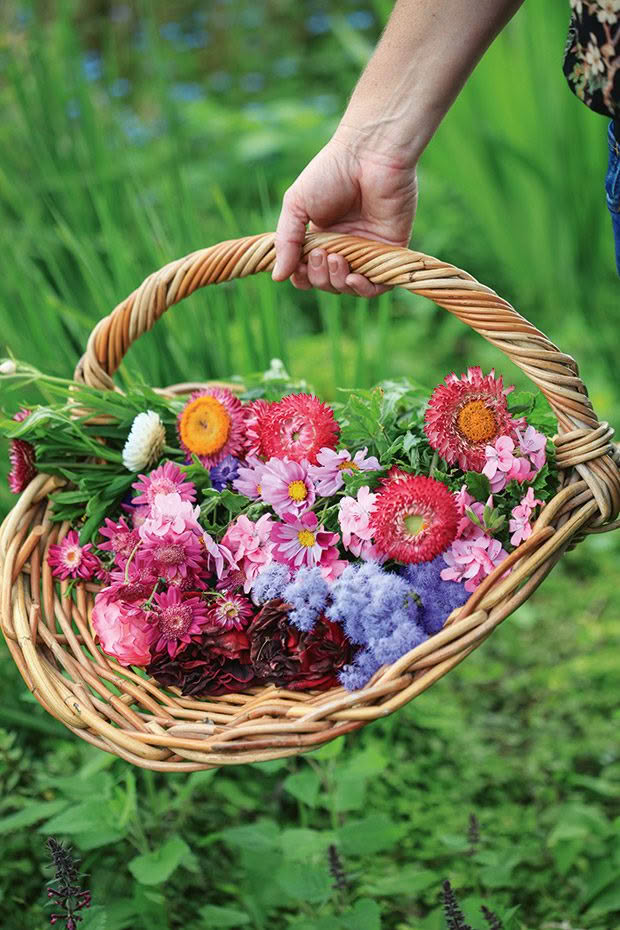
When the mercury rises in midsummer, Lynda’s abundant cut flower garden starts to lose its lustre. She harvests flowers destined for drying as soon as the dew has evaporated each morning.
Mix fresh flowers with dried, or grow flowers that look dried even when fresh, such as hybrid mānuka, acroclinium, annual and perennial statice, and australian rice flowers (Ozothamnus diosmifolius).
Get creative with garden prunings. It’s easy to craft simple wreaths from the pliable new season’s tendrils of thuggish garden vines such as wisteria, ivy and Clematis montana. Last summer, I twisted and tied together a dozen crooked circles from a grapevine that had jumped the boundary fence at our holiday home.
Long-stemmed flowers that are hung to dry end up looking artificially ramrod straight in dried arrangements. For a more natural look, arrange a fresh posy of homegrown flowers, tie the stems tightly and hang it to dry, or pop it into a vase of water and set aside in a warm spot out of direct sunlight until all the water has evaporated. This method works particularly well with late summer hydrangeas.
MORE HERE
Lynda Hallinan’s Blog: A remodeled little hen house on the prairie
 This article first appeared in NZ Life & Leisure Magazine.
This article first appeared in NZ Life & Leisure Magazine.
